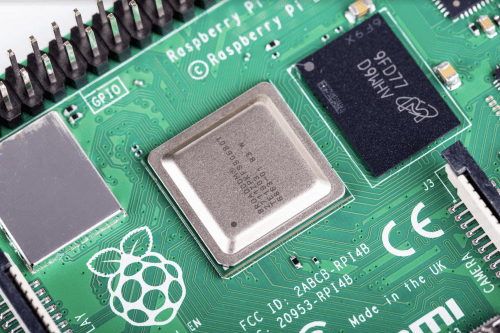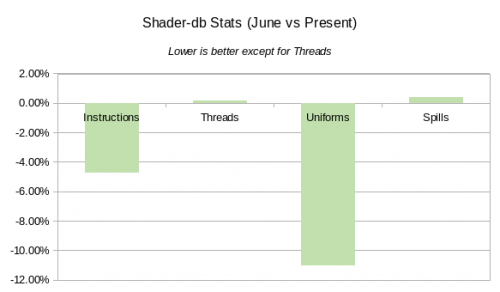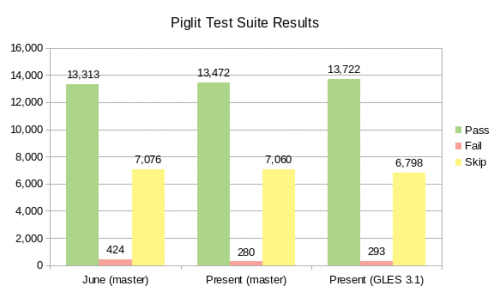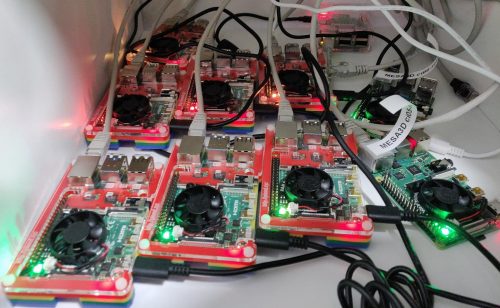Here’s an update from Iago Toral of Igalia on development of the open source VC4 and V3D OpenGL drivers used by Raspberry Pi.
Some of you may already know that Eric Anholt, the original developer of the open source VC4 and V3D OpenGL drivers used by Raspberry Pi, is no longer actively developing these drivers and a team from Igalia has stepped in to continue his work. My name is Iago Toral (itoral), and together with my colleagues Alejandro Piñeiro (apinheiro) and José Casanova (chema), we have been hard at work learning about the V3D GPU hardware and Eric’s driver design over the past few months.

Learning a new GPU is a lot of work, but I think we have been making good progress and in this post we would like to share with the community some of our recent contributions to the driver and some of the plans we have for the future.
But before we go into the technical details of what we have been up to, I would like to give some context about the GPU hardware and current driver status for Raspberry Pi 4, which is where we have been focusing our efforts.
The GPU bundled with Raspberry Pi 4 is a VideoCore VI capable of OpenGL ES 3.2, a significant step above the VideoCore IV present in Raspberry Pi 3 which could only do OpenGL ES 2.0. Despite the fact that both GPU models belong in Broadcom’s VideoCore family, they have quite significant architectural differences, so we also have two separate OpenGL driver implementations. Unfortunately, as you may have guessed, this also means that driver work on one GPU won’t be directly useful for the other, and that any new feature development that we do for the Raspberry Pi 4 driver stack won’t naturally transport to Raspberry Pi 3.
The driver code for both GPU models is available in the Mesa upstream repository. The codename for the VideoCore IV driver is VC4, and the codename for the VideoCore VI driver is V3D. There are no downstream repositories – all development happens directly upstream, which has a number of benefits for end users:
- It is relatively easy for the more adventurous users to experiment with development builds of the driver.
- It is fairly simple to follow development activities by tracking merge requests with the
V3DandVC4labels.
At present, the V3D driver exposes OpenGL ES 3.0 and OpenGL 2.1. As I mentioned above, the VideoCore VI GPU can do OpenGL ES 3.2, but it can’t do OpenGL 3.0, so future feature work will focus on OpenGL ES.
Okay, so with that introduction out of the way, let’s now go into the nitty-gritty of what we have been working on as we ramped up over the last few months:
Disclaimer: I won’t detail here everything we have been doing because then this would become a long and boring changelog list; instead I will try to summarize the areas where we put more effort and the benefits that the work should bring. For those interested in the full list of changes, you can always go to the upstream Mesa repository and scan it for commits with Igalia authorship and the v3d tag.
First we have the shader compiler, where we implemented a bunch of optimizations that should be producing better (faster) code for many shader workloads. This involved work at the NIR level, the lower-level IR specific to V3D, and the assembly instruction scheduler. The shader-db graph below shows how the shader compiler has evolved over the last few months. It should be noted here that one of the benefits of working within the Mesa ecosystem is that we get a lot of shader optimization work done by other Mesa contributors, since some parts of the compiler stack are shared across multiple drivers.

Evolution of the shader compiler (June vs present)
Another area where we have done significant work is transform feedback. Here, we fixed some relevant flushing bugs that could cause transform feedback results to not be visible to applications after rendering. We also optimized the transform feedback process to better use the hardware for in-pipeline synchronization of transform feedback workloads without having to always resort to external job flushing, which should be better for performance. Finally, we also provided a better implementation for transform feedback primitive count queries that makes better use of the GPU (the previous implementation handled all this on the CPU side), which is also correct at handling overflow of the transform feedback buffers (there was no overflow handling previously).
We also implemented support for OpenGL Logic Operations, an OpenGL 2.0 feature that was somehow missing in the V3D driver. This was responsible for this bug, since, as it turns out, the default LibreOffice theme in Raspbian was triggering a path in Glamor that relied on this feature to render the cursor. Although Raspbian has since been updated to use a different theme, we made sure to implement this feature and verify that the bug is now fixed for the original theme as well.
Fixing Piglit and CTS test failures has been another focus of our work in these initial months, trying to get us closer to driver conformance. You can check the graph below showcasing Piglit test results to have a quick view at how things have evolved over the last few months. This work includes a relevant bug fix for a rather annoying bug in the way the kernel driver was handling L2 cache invalidation that could lead to GPU hangs. If you have observed any messages from the kernel warning about write violations (maybe accompanied by GPU hangs), those should now be fixed in the kernel driver. This fix goes along with a user-space fix to go that should be merged soon in the upstream V3D driver.

Evolution of Piglit test results (June vs present)
A a curiosity, here is a picture of our own little continuous integration system that we use to run regression tests both regularly and before submitting code for review.

Our continuous integration system
The other big piece of work we have been tackling, and that we are very excited about, is OpenGL ES 3.1, which will bring Compute Shaders to Raspberry Pi 4! Credit for this goes to Eric Anholt, who did all the implementation work before leaving – he just never got to the point where it was ready to be merged, so we have picked up Eric’s original work, rebased it, and worked on bug fixes to have a fully conformant implementation. We are currently hard at work squashing the last few bugs exposed by the Khronos Conformance Test Suite and we hope to be ready to merge this functionality in the next major Mesa release, so look forward to it!
Compute Shaders is a really cool feature but it won’t be the last. I’d like to end this post with a small note on another important large feature that is currently in early stages of development: Geometry Shaders, which will bring the V3D driver one step closer to exposing a full programmable 3D pipeline – so look forward to that as well!
Website: LINK
